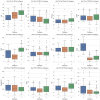Deciphering the impact of sepsis phenotypes on improving clinical outcome predictions: a multicenter retrospective analysis based on critical care in China
- PMID: 40200027
- PMCID: PMC11978960
- DOI: 10.1038/s41598-025-93961-y
Deciphering the impact of sepsis phenotypes on improving clinical outcome predictions: a multicenter retrospective analysis based on critical care in China
Abstract
Sepsis is a clinically heterogeneous disease with high mortality. It is crucial to develop relevant therapeutic strategies for different sepsis phenotypes, but the impact of phenotypes on patients' clinical outcomes is unclear. This study aimed to identify potential sepsis phenotypes using readily available clinical parameters and assess their predictive value for 28-day clinical outcomes by logistic regression analysis. In this retrospective analysis, researchers extracted clinical data from adult patients admitted to the First Affiliated Hospital of Anhui Medical University between April and August 2022 and from the 2014-2015 eICU Collaborative Study database. K-Means clustering was utilized to identify and refine sepsis phenotypes, and their predictive performance was subsequently evaluated. Logistic regression models were trained independently for each phenotype and five-fold cross-validation was used to predict clinical outcomes. Predictive accuracy was then compared to traditional non-clustered prediction methods using model assessment scores. The study cohort consisted of 250 patients from the First Affiliated Hospital of Anhui Medical University, allocated in a 7:3 ratio for training and testing, respectively, and an external validation cohort of 3100 patients from the eICU Cooperative Research Database. The results of the phenotype-based prediction model demonstrated an improvement in F1 score from 0.74 to 0.82 and AUC from 0.74(95%CI 0.71-0.80) to 0.84(95%CI 0.82-0.87), and these results also highlight the superiority of clinical outcome prediction with the help of sepsis phenotypes over traditional prediction methods. Phenotype-based prediction of 28-day clinical outcomes in sepsis demonstrated significant advantages over traditional models, highlighting the impact of phenotype-driven modeling on clinical outcomes in sepsis.
Keywords: Clustering algorithms; Intensive care; Machine learning; Phenotypes; Sepsis.
© 2025. The Author(s).
Conflict of interest statement
Declarations. Competing interests: The authors declare no competing interests. Informed consent: The study protocol was approved by the research ethics board of our institution, and all patients provided informed consent before their medical records was reviewed. The performance of this study conformed with the Declaration of Helsinki.
Figures






Similar articles
-
Prediction of In-hospital Mortality in Emergency Department Patients With Sepsis: A Local Big Data-Driven, Machine Learning Approach.Acad Emerg Med. 2016 Mar;23(3):269-78. doi: 10.1111/acem.12876. Epub 2016 Feb 13. Acad Emerg Med. 2016. PMID: 26679719 Free PMC article.
-
Interpretable machine learning for 28-day all-cause in-hospital mortality prediction in critically ill patients with heart failure combined with hypertension: A retrospective cohort study based on medical information mart for intensive care database-IV and eICU databases.Front Cardiovasc Med. 2022 Oct 12;9:994359. doi: 10.3389/fcvm.2022.994359. eCollection 2022. Front Cardiovasc Med. 2022. PMID: 36312291 Free PMC article.
-
[Construction of a predictive model of death for sepsis-associated acute kidney injury].Zhonghua Wei Zhong Bing Ji Jiu Yi Xue. 2024 Apr;36(4):381-386. doi: 10.3760/cma.j.cn121430-20240130-00098. Zhonghua Wei Zhong Bing Ji Jiu Yi Xue. 2024. PMID: 38813632 Chinese.
-
[Establishment and validation of a sepsis 28-day mortality prediction model based on the lactate dehydrogenase-to-albumin ratio in patients with sepsis].Zhonghua Wei Zhong Bing Ji Jiu Yi Xue. 2024 Nov;36(11):1140-1146. doi: 10.3760/cma.j.cn121430-20231012-00865. Zhonghua Wei Zhong Bing Ji Jiu Yi Xue. 2024. PMID: 39697017 Chinese.
-
Sepsis subphenotypes: bridging the gaps in sepsis treatment strategies.Front Immunol. 2025 Feb 6;16:1546474. doi: 10.3389/fimmu.2025.1546474. eCollection 2025. Front Immunol. 2025. PMID: 40013154 Free PMC article. Review.
References
-
- Verdonk, F., Blet, A. & Mebazaa, A. The new sepsis definition. Curr. Opin. Anaesthesiol.30 (2), 200–204. 10.1097/aco.0000000000000446 (2017). - PubMed
-
- Peach, B. C. Implications of the new sepsis definition on research and practice. J. Crit. Care38, 259–262. 10.1016/j.jcrc.2016.11.032 (2017). - PubMed
Publication types
MeSH terms
Grants and funding
LinkOut - more resources
Full Text Sources
Medical
Miscellaneous

